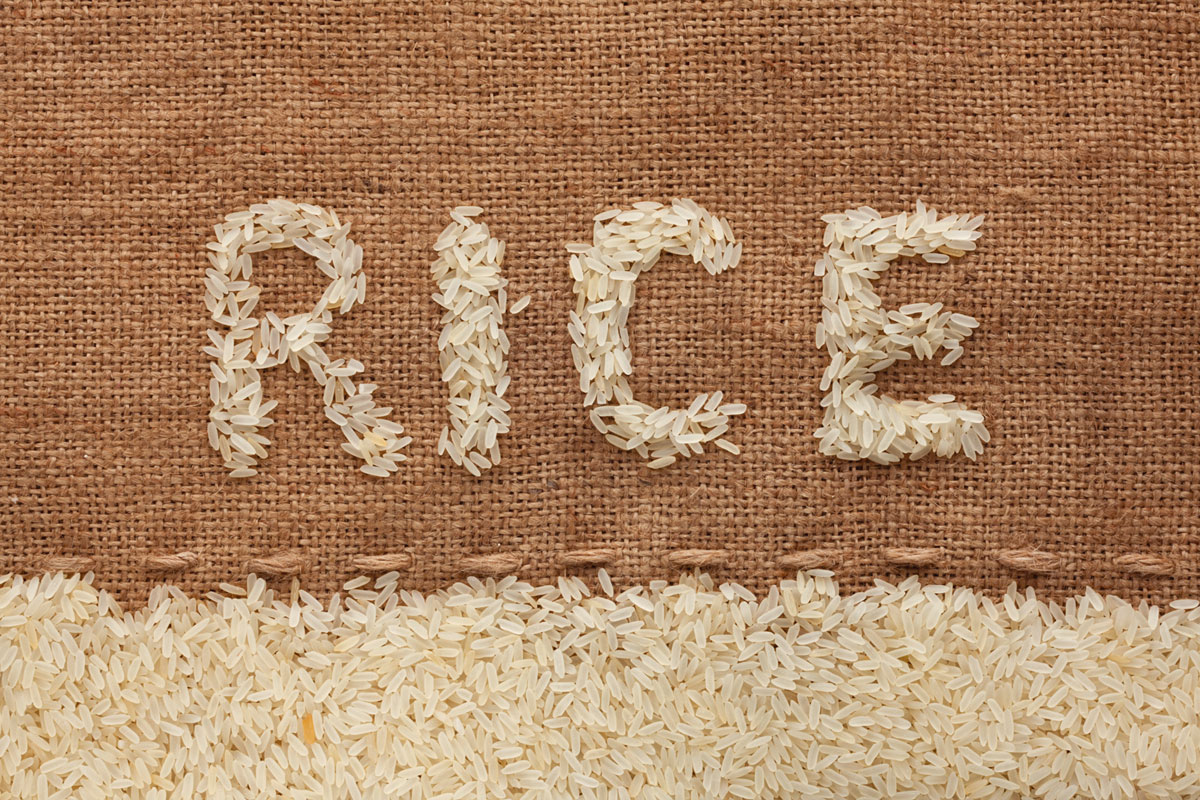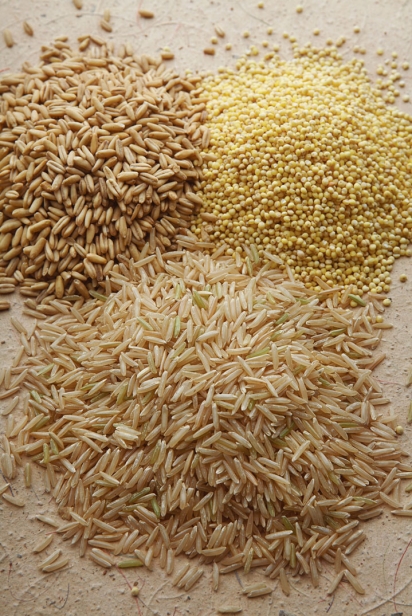The 1-Minute Rice Meditation: An Essential Exercise
Cooking rice has become a small, but satisfying ritual for me. Standing at my kitchen sink, I run tepid water into the pot, covering the rice completely. I swish my hand through the grains languidly, back and forth, back and forth, before I drain and repeat. It’s a meditative process that takes less than a minute; a peaceful way to begin the dinner hour, a previously frenetic time. I learned this procedure, which I now use on all grains, from a multitude of Asian and Indian acquaintances who told me “of course they rinse their rice, they learned it from their mothers.”
It’s a far cry from the various methods my American mother used in our kitchen. She boiled rice, sautéed and simmered it, and - egad! - sometimes submerged an entire plastic bag of the artificially flavor-filled stuff in a pot of boiling water.
Why the difference in cultural cooking methods between Asian and American? The answer lies mainly in Americans’ choice of processed rice. Par-cooked and polished, enriched white rice became the product of choice for American consumers starting in the 1950s. Unfortunately the milling process, which strips rice of its bran and germ, also robs it of most of its nutrients. To compensate for this lack, white rice became required by law to be enriched with both B-vitamins and iron. The way vitamins are added to rice is via a spray-on method, enabling them to be absorbed into the grains from the cooking water; therefore if you rinse enriched white rice prior to cooking, these added nutrients would actually go right down the drain! In addition to supplementing with vitamins and iron, food manufacturers figured out how to add various flavors and seasonings to the rice mix which could also be absorbed during the cooking process. Often artificially flavored and colored, and high in unhealthy levels of sodium, these highly processed rice products are not the healthful, fiber-rich whole food rice is meant to be.
Whole grain brown rice, on the other hand, needs no enrichment or fortification as the highly nutritious germ and bran are left intact. These provide a grain that is naturally rich in fiber, B vitamins, and iron. Brown rice also contains magnesium, a nutrient that is not added back to white rice during the enrichment process. The rice bran oil inherent in brown rice also contains vitamin E and antioxidants, which studies show to be beneficial both in lowering cholesterol and battling menopausal hot flashes. This oil is also being explored as an anti-cancer agent.
White rice grown in Asian countries is not generally enriched to supplement the nutrients lost during the milling process, nor do Asians traditionally eat brown rice. Common varietals include jasmine, basmati and japonica, but always white. Bagged rice is often coated with a starchy substance such as powdered glucose, talc or rice powder, which would make for a gluey or gummy end product if it were not rinsed off prior to cooking. Other reasons for rinsing rice include quicker cooking and sometimes germination (an exception to the white rice rule is the highly nutritious Japanese genome, a dish that entails soaking brown rice kernels prior to cooking).
However, if Americans didn’t learn to rinse their rice before cooking, now is the right time for us to adopt this practice.
I started to rinse - or wash - my rice, not for cultural reasons but because of reports that rice contained arsenic. And although this information turned out to be true, being informed on the topic can help you reduce the amount you are exposed to in your diet, while still enjoying this nutrient-rich grain. What are the facts?
Rice can contain two different types of arsenic, organic and inorganic. Organic arsenic (note: this organic is a chemistry term and not to be confused with food) occurs naturally in soil and water, and all plants take some in. This is especially true for rice because it grows in water-flooded conditions, and absorbs the arsenic through its roots, then stores it in its grains. More dangerous, though, is inorganic arsenic due to its carcinogenic properties. The presence of inorganic arsenic in rice is like history coming back to haunt us. Arsenic-containing pesticides were widely used on cotton plants and, though officially banned in the U.S. in 1988, the residue still lingers in soil where cotton was grown.
Unfortunately this includes rice growing states in the south-central region of our country, including Arkansas (the number one rice producing state in the U.S.), Louisiana, Mississippi, Missouri and Texas. As the rice is grown where cotton once grew, the crop absorbs elevated levels of inorganic arsenic.
The lucky exception is California; since its soil was too claylike to support a cotton crop, arsenic-laden pesticides were never sprayed there. As a result, California rice contains far less inorganic arsenic than rice grown in the south-central states. In fact, research shows that California white rice contains 38% less inorganic arsenic than rice grown in the south-central region of the U.S.!
White Rice vs. Brown Rice
It makes sense that there are lower levels of arsenic in white rice since the outer portion of the grain is removed during the milling process. This reduces the area that most effectively holds the arsenic. However, since white rice is lacking in vitamins, minerals and fiber, it still makes sense to eat highly nutritious brown rice; simply take the basic steps necessary to reduce the amount of arsenic. The first step is to buy rice that contains the lowest levels. According to Consumer Reports, brown basmati rice from California, India, or Pakistan contains approximately one-third less inorganic arsenic than other brown rices.
Should You Buy Organic Rice?
While the organic label generally offers security against exposure to harmful toxins in your food, unfortunately you cannot rely on it to safeguard you from arsenic in rice. Environmental arsenic affects both conventional and organic crops the same way. Even a product as innocuous sounding as ‘organic baby rice cereal’ can contain five times the amount of inorganic arsenic than a good alternative, such as oatmeal. The recommendation is that children’s exposure to rice products - organic or conventional - should be limited. (Concerned parents should read the Consumer Reports article “How much arsenic is in your rice?” Nov, 2014. http://consumerreports.org/cro/magazine/2012/11/arsenic-in-your-food/index.htm).
Smart Practices
Rice is not only the most popular grain, in fact it is the most widely consumed food in the world! There are simple ways to reduce the amount of arsenic it holds, so it serves us well to adopt the following practices to ensure we are eating the healthiest product in the safest way.
1 Start with a nutritious rice that has the lowest arsenic content, such as rice grown in California. Remember that the central-southern regions of the United States have the highest levels of arsenic in their rice. Forty-nine percent of U.S. rice is from Arkansas, and rice from Texas has the highest arsenic content, so read labels! Though white rice has less inorganic arsenic, its nutritional value is negligible, so I always recommend brown rice for its nutrients and fiber.
2 Always rinse any type of rice, as well as any other grain you cook. Rinsing, an exercise that takes under a minute, can reduce arsenic levels by about 30%. Here’s how to do it: Pour the desired amount of rice into a pot that allows for a generous amount of water, and fill. Swish the water around the rice, then pour it off. Repeat this process 3 - 4 times. Be sure to use clear water to cook.
3 Try exotic varieties of rice from countries such as India or Thailand, as these can contain much lower levels of inorganic arsenic. Varieties such as basmati or japonica from these countries can contain ½ to ⅓ the amount of inherent inorganic arsenic. (Good news: sushi rice is japonica.)
4 Take advantage of the wide array of whole grains that are now widely available. Varying your selection will not only reduce your exposure to arsenic, it will also jazz up your menu! Although other grains do not absorb arsenic to the extent rice does, it’s still a good idea to rinse them.
Meditative Cooking
Rinsing rice has taught me there’s a soulful, thoughtful manner to which I can approach an otherwise harried dinner hour - and hush - if just for a moment. For anyone who says they don’t have time, I would propose you do. Call it “The One-Minute Rice Meditation”: it’s essential for healthful rice preparation, in any case.
The calm with which I prepare my rice has now spilled over to other kitchen chores; peeling carrots, chopping onions, even washing dishes (sometimes!). It’s a rhythmic and meditative process, as simple as that. One which needs to be completed, no matter your cultural orientation. Why not do it mindfully? Teach it to your children, so they, too, can say “my mother (or father) taught me.”
Note: Since 2012, Consumer Reports has urged the FDA to establish standards for safe rice consumption, based on the danger arsenic poses. They have tested over 60 rices and 200 sample foods that are made from rice, including cereals, pasta, baby foods and rice drinks, as well as both brown and white rices from every category. They revisited their research in 2014.
The U.S. Rice Federation, as well as the FDA, is predictably blasé about the issue of rice and arsenic. I urge anyone more concerned to review the Consumer Reports article: http://www.consumerreports.org/cro/magazine/2015/01/how-much-arsenic-is-in-your-rice/index.htm








